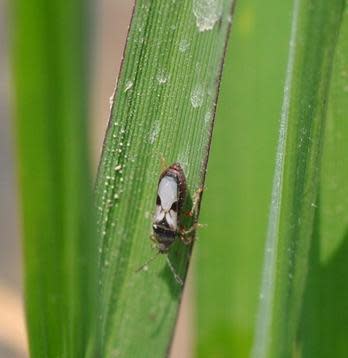Campbell Vaughn: Chinch bugs are a major pest for St. Augustine lawns in hot, dry weather

The heat is on. And the rain isn’t.
I got a call the other day asking if I had been seeing any chinch bugs around town and I had to admit that I really hadn’t, but I was expecting them very soon.
When it gets hot and dry, chinch bugs love to come out and attack St. Augustine grass.
Many people have St. Augustine grass in shady areas because it is one of our most shade tolerant grasses.
In shade, you are safe from chinch bug outbreaks, but if you have hot, sunny and dry areas of St. Augustine, good luck. Chinch bugs love these areas of the lawn. They especially like areas with radiating heat near driveways, curbs and sidewalks.
The first sign of chinch bug damage to a St. Augustine lawn is the grass will look wilted and will progress to a yellow tint. Quickly, after those initial signs, the grass will turn straw-colored brown. Soon after, the local grass coroner will have to be called.

Young chinch bug nymphs are about the size of a pin head, red to orange in color with a white band across their back. The full-grown nymph (just before the adult stage) is black and has a white spot on the back between the wing pads. Like most insects, the nymphs do more damage than the adults.
Sometimes it can be confusing knowing what you are looking for with chinch bugs depending on their life cycles. The adults are black and about one-sixth inch long. The wings are folded over the back forming a white or silver cross-shaped mark. The white markings will look a little different depending on the life stage.
Chinch bugs are fairly quick and hard to catch. I definitely have to put my readers on to look for them in the lawn. To find them, I search in the wilted grass at the edge of the healthy grass. I will part the grass and pull back the thatch down to the soil. You can sometimes see them easier in thin areas crawling across the top. If you do not see the chinch bugs initially, pull up a handful of grass including the thatch and runners. Lay it on a table or put it in a plastic bag and see if they crawl out. Next, gently pull off the leaves to see if the bugs are hiding where the grass blades come together at the base of the plant.
Campbell Vaughn: Though century plants take ages to bloom, they're worth the wait
If the chinch bugs are only causing damage in a small part of the yard, just apply spot treatments with granular or liquid insecticides. Synthetic pyrethroid insecticides are effective in control of chinch bugs, but most of them don’t provide residual control. All the synthetic pyrethroid insecticides end in “thrin.” These include bifenthrin (Ortho Max Bug-B- Gon or Hi-Yield Bug Blaster) or permethrin. Some of the products also are available mixed a systemic insecticide like imidacloprid that will help with longer control.
During the hot summer months, use slow-release fertilizers. Overfertilization with nitrogen can make chinch bugs worse. Water deeply about once or twice per week applying three-quarters to one inch of water each time. Water in the early morning if possible. Do your best to remove the thatch layer when it gets over an inch.
Chinch bugs like many insects have multiple generations per season. It is rare that you get them all when trying to control them, so don’t be surprised if you see multiple outbreaks in a season. If this weather stays hot and dry, they will be a factor the rest of the summer and even into early fall.
I have seen a lawn disappear in a matter of a week because of a heavy chinch bug infestation. Like dead. Not coming back. Plan on getting new grass.
This article originally appeared on Augusta Chronicle: Campbell Vaughn: Chinch bugs a problem for St. Augustine lawns




